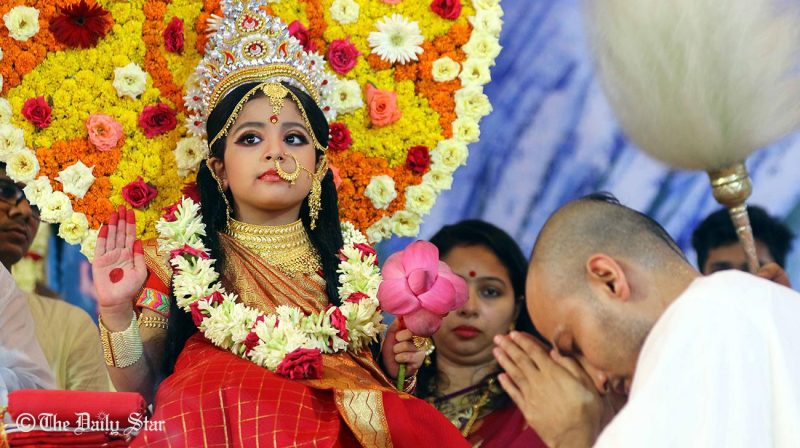Day 8: Maha Ashtami
Day 8The 8th day of Dashain, Maha Asthami, is dedicated to Kali, the fiercest form of the goddess Durga.
Kali is the feminine form of the word “black” and is therefore depicted with dark blue skin. Her hair is wild, her tongue (and sometimes fangs) stick out), and stands atop her sleeping husband, Shiva. Depicted with either 10 or 4 arms, these hold multiple weapons, a severed head, a bowl catching the falling blood, holy items, and symbolic gestures. Clothed in only a skirt of tiger skin and human arms, her necklace is made up of skulls/human heads.
The Hindu scripture the Devi Mahatmyam depicts the origin of Kali, soon after Duga’s battle with the water-buffalot-demon Mahishasura. Locked in raging battle, two demons attacked Durga who was so enraged that her face turns black and from her third eye Kali emerges. After immediately slaughtering the two demons, Kali goes on to face Raktabija who is able to reproduce himself from every drop of blood that touches the ground. Kali goes wild, lapping up his blood she spills before it can reach the ground, effectively destroying Raktabija. The 8th day of Dashain celebrates Kali’s victory over the demon.
On this day night, Kal Ratri or “black night,” numerous animal sacrifices are performed to appease Kali, in both households and temples. At midnight, 54 buffalo and 54 goats are sacrificed in the courtyard of the Kathmandu palace. After offering the blood to the gods, the meat is taken home to be cooked and eaten along with a feast. This meat is considered blessed. The meat is offered to household idols on leaf plates and then consumed by the family. Although some replace the animal sacrifices with coconuts, most families sacrifice either a goat, sheep, or buffalo.
 Due to her victory in battle, the weapons of Durga, and by extension all weapons, are worshipped on this day. A worship ceremony is also conducted for the young unmarried girls in the household, between ages 2 and 10, in order to represent the 9 forms of the goddess Durga. The family of the girls worship for certain blessings according to the caste they belong to: if from the Brahmin caste, they seek the granting of wishes, if from the Kshatriya caste, for glory and fame, if the Vaishya caste, wealth and prosperity, if the Sudra caste, the birth of a son. After the worship ceremony, the girls are given fed sweets and special foods and given gifts and money.
Due to her victory in battle, the weapons of Durga, and by extension all weapons, are worshipped on this day. A worship ceremony is also conducted for the young unmarried girls in the household, between ages 2 and 10, in order to represent the 9 forms of the goddess Durga. The family of the girls worship for certain blessings according to the caste they belong to: if from the Brahmin caste, they seek the granting of wishes, if from the Kshatriya caste, for glory and fame, if the Vaishya caste, wealth and prosperity, if the Sudra caste, the birth of a son. After the worship ceremony, the girls are given fed sweets and special foods and given gifts and money.
____________________________________________________________________________________________________________________________________
https://en.wikipedia.org/wiki/Dashain
http://www.weallnepali.com/nepali-festivals/maha-asthami
